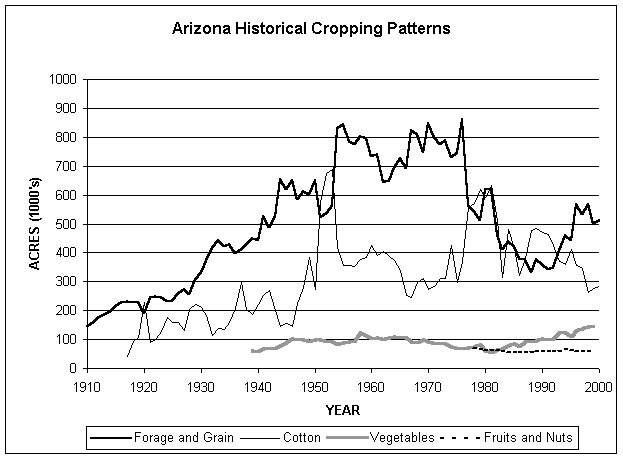Historical Cropping Patterns in Arizona
Mike Ottman,
Extension Agronomist, University of Arizona
August, 2001
Arizona has a long history of crop cultivation. Native Americans have been growing corn, legumes, and other crops in Arizona for hundreds of years. Barley, wheat, and melons were introduced in the late 1600's during the missionary period. Many of the crops currently grown in Arizona were first introduced in the 1800's. Forage crops, primarily alfalfa, were the first crops grown on a large scale in Arizona. Cotton cultivation was well-established by 1920. Acreage estimates were not available for vegetables until 1939 and for fruits until 1978. The average crop acreages between 1939 and 1999 were 601,000 (forage and grains), 373,000 (cotton), 94,000 (vegetables) and, since 1978, 61,000 (fruits and nuts). Between 1990 and 1999, forage and grain crop area increased by 139,000 acres, cotton area declined by 194,000 acres, vegetable area increased by 41,000 acres, and fruit and nut crop acreage remained unchanged. The increase forage and grain crops acreage was due primarily to alfalfa (35,000), other hay (10,000), barley (46,000), and corn (46,000). The increase in vegetable acreage was due primarily to romaine (9,800), broccoli (7,400), potatoes (3,100), dry onions (3,000), honeydew (1,800), and miscellaneous vegetables (12,500) especially chili, sweet corn, and spinach.

Issued in furtherance of Cooperative Extension work, acts of May 8 and June 30, 1914, in cooperation with the U.S. Department of Agriculture, James A. Christenson, Director Cooperative Extension, College of Agriculture and Life Sciences, The University of Arizona.
The University of Arizona is an equal opportunity, affirmative action institution. The University does not discriminate on the basis of race, color, religion, sex, national origin, age, disability, veteran status, or sexual orientation in its programs and activities.
Any products, services, or organizations that are
mentioned, shown, or indirectly implied in this web document do not imply
endorsement by The University of Arizona.
Information provided by:
Michael Ottman, mottman@ag.arizona.edu Agronomy Specialist
University of Arizona, Tucson, Arizona.
Material written May 2002.
For more Arizona Production Ag Information:
Home | Cotton | Veggies| Forages | Grains | Citrus | Crop x Crop | Insects | Diseases| Weeds | Pesticides | News | Weather | Research | Photos | Contacts | General Info. | Site Map
document located at: http://cals.arizona.edu/crops/counties/yuma/farmnotes/fn0101.html
Copyright © 2001 University of Arizona,
College of Agriculture and Life Sciences
Webmaster: Al Fournier (fournier@ag.arizona.edu)